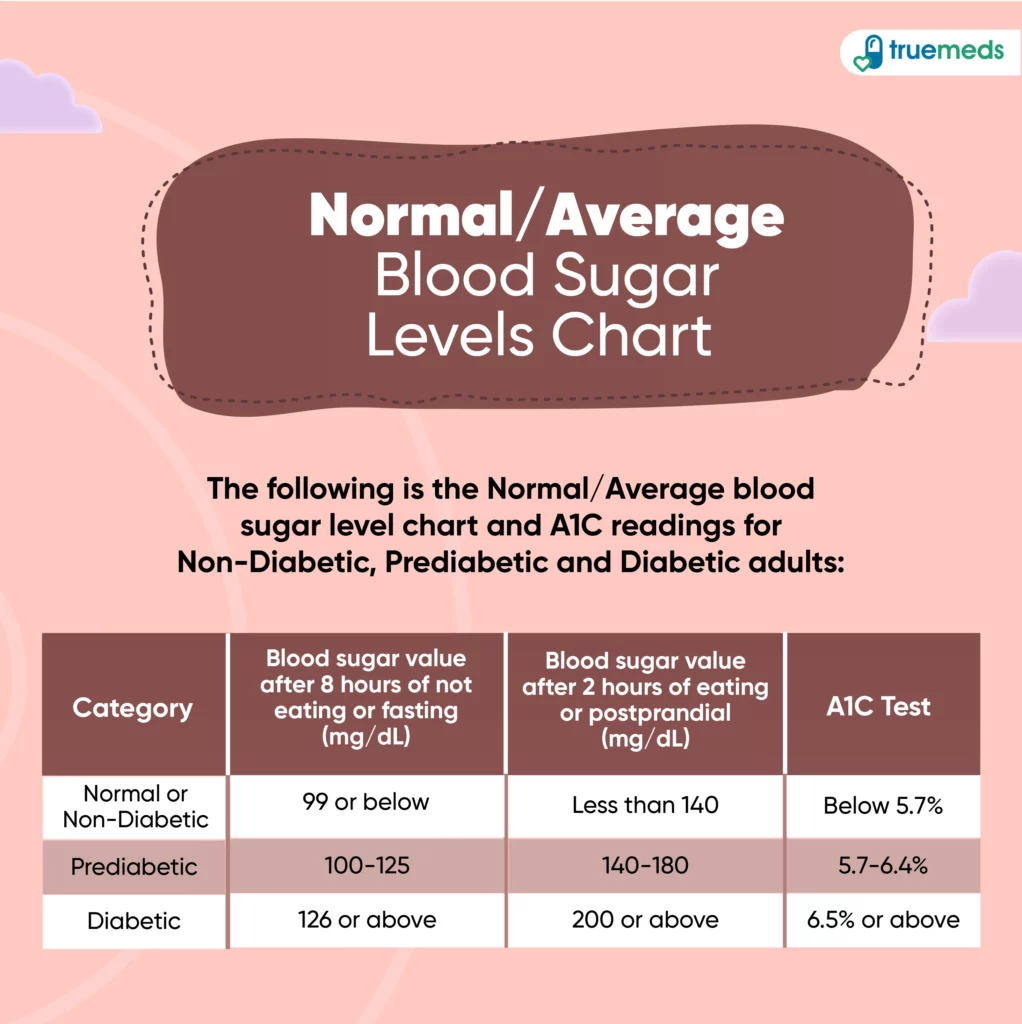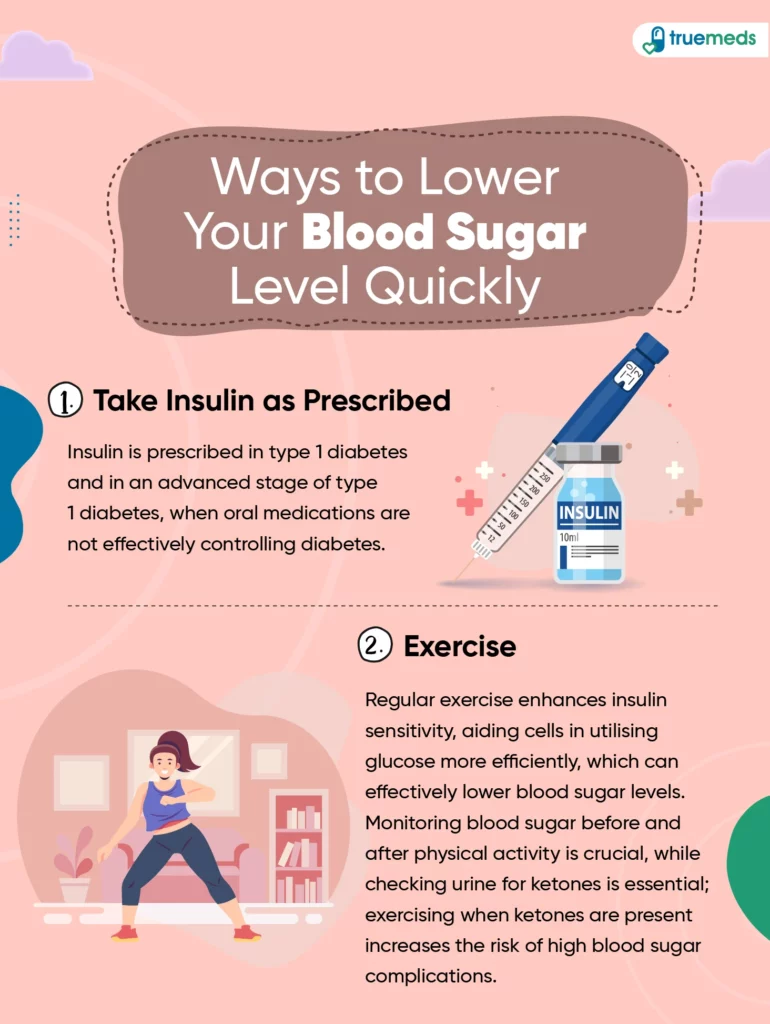How Much Blood Sugar Level is Dangerous in Diabetes: Normal Level and Chart
Last updated on : 12 Nov, 2024
Read time : 11 min
Diabetes is a health condition where the body is unable to manage blood sugar (glucose) levels. Insulin, a hormone produced by the pancreas, helps our body to manage these levels. It helps glucose enter cells, providing energy. In diabetes, the body either doesn’t produce enough insulin (Type 1) or doesn’t use it effectively (Type 2), leading to high blood sugar levels.
Keeping track of blood sugar levels is vital for managing diabetes. Monitoring your body regularly for sugar levels helps you understand how it responds to food, activity, and medication. You can prevent complications like heart disease and nerve damage by staying aware of normal blood sugar levels. You can make informed decisions about your food and adjust medication based on your blood sugar. Read more to know the normal and dangerous blood sugar levels and how to manage such conditions.
What are Normal Blood Sugar Levels Before and After Eating?
A healthy individual without diabetes should have a normal blood sugar level range between 70 to 100 mg/dL before meals, that should remain below 180 mg/dL two hours after meals. This balance ensures the body has the energy it needs without causing diabetes complications.
Dangerous Blood Sugar Levels – High Range
When your blood sugar is 180 to 250 mg/dL mg/dL, it’s considered high. If it falls beyond 250 mg/dL, it is considered a dangerously high sugar level.
High blood sugar, or hyperglycemia, happens when there’s too much sugar in your blood. People with diabetes often experience this, either because their bodies don’t make enough insulin (a hormone that helps sugar get into cells for energy) or because their bodies don’t use insulin properly. However, anyone, including those without diabetes, can have temporary spikes in blood sugar due to the following reasons:
- Insufficient insulin
- Missed doses of diabetes medicine
- High carb diet
- Reduced physical activity
- Certain illness
- Emotional stress
- Increased blood sugar levels in the early morning (the dawn phenomenon)
- Somogyi effect, when blood sugar drops overnight, prompts the body to produce more sugar, resulting in higher blood sugar levels in the morning.
In a hyperglycemic state or when your blood sugar is high, you may experience excessive thirst, frequent urination, fatigue, and blurred vision. Children may show signs like frequent bedwetting and excessive hunger. Pregnant individuals may have increased thirst, frequent urination, and a higher risk of gestational diabetes.
If you have diabetes, regularly checking your blood sugar levels with a glucometer can confirm whether it’s too high.
If left untreated, high blood sugar can cause complications in adults, children, and during pregnancy. In adults, it may cause long-term issues like heart disease, kidney problems, nerve damage, and diabetic ketoacidosis. Untreated high blood sugar can impact children’s growth and development, leading to potential learning difficulties. In pregnant women, uncontrolled gestational diabetes can pose risks to both the mother and the baby. Complications may include a higher chance of birth defects, preterm birth, and other pregnancy-related issues.
It’s essential to address high blood sugar promptly. Taking your medication medications or insulin. Eating a balanced diet, staying physically active, and managing stress are key components of keeping blood sugar levels in check.
Dangerous Blood Sugar Level – Low Range
It’s considered low when your blood sugar falls below 70 mg/dL. If it drops even more, below 54 mg/dL, it is considered dangerously low. You might faint (pass out). You usually need medical help to treat it when it gets that low.
Low blood sugar level, or hypoglycemia, is commonly experienced by individuals with diabetes, particularly those using insulin or certain medications. Hypoglycemia can also be experienced due to excessive alcohol consumption and certain medications.
You may experience shakiness, sweating, irritability, confusion, and dizziness during low blood sugar. Severe cases can result in unconsciousness or seizures. Children might display irritability and difficulty concentrating. Regular blood sugar monitoring with a glucometer, especially for individuals with diabetes, helps detect and address low levels.
Untreated low blood sugar can lead to complications in adults, children, and during pregnancy. In adults, it may cause cognitive impairments, mood changes, and in severe cases, seizures or loss of consciousness. Children may experience learning difficulties, behavioral changes, and, in extreme situations, seizures. In pregnancy, untreated low blood sugar poses risks to both the mother and the baby. Complications may include preterm birth, developmental issues, and in rare cases, fetal distress.
To prevent complications, it’s important to have a proactive approach. Regular blood sugar monitoring, adherence to medication schedules, adjusting medication doses and maintaining a consistent eating schedule can help reduce the chances of low blood sugar. If you experience low blood sugar, its best to consume quick-acting carbohydrates, such as glucose tablets, 1 tablespoon of sugar, honey, or syrup, hard candy, regular soda, juice or sugary foods, to raise blood sugar levels. Avoid having carbs high in fibre, like beans or lentils, and carbs that contain fat, such as chocolate. Fiber and fat can slow down the absorption of sugar, affecting how quickly your body takes it in.
Normal/Average Blood Sugar Levels Chart

The following is the Normal/Average blood sugar level chart and A1C readings for Non-Diabetic, Prediabetic and Diabetic adults:
| Category | Blood sugar value after 8 hours of not eating or fasting (mg/dL) | Blood sugar value after 2 hours of eating or postprandial (mg/dL) | A1C Test |
| Normal or Non-Diabetic | 99 or below | Less than 140 | Below 5.7% |
| Prediabetic | 100-125 | 140-180 | 5.7-6.4% |
| Diabetic | 126 or above | 200 or above | 6.5% or above |
What is A1C Test and its Role in Managing Diabetes?
Usually, we check our blood glucose levels with a glucometer, which is a simple and convenient way to have a glance at the real-time blood sugar levels. Unlike the glucometers, which show just a quick reading, the A1C test measures average blood sugar levels over the past 2-3 months. This test is of extreme significance in diabetes care. It offers a comprehensive perspective on how well you are managing diabetes. It reflects overall control and helps assess the risk of complications.
A1C test measures the average amount of sugar attached to your red blood cells during this time. A non-diabetic A1C level is under 5.7%, showing good blood sugar control. If it falls between 5.7% and 6.4%, it signals prediabetes, a stage where you’re at risk of developing type 2 diabetes. An A1C level of 6.5% or higher indicates diabetes. In the prediabetes range (5.7% to 6.4%), the higher your A1C, the more likely it is that you may progress to type 2 diabetes.
The goal for diabetics should be to keep the A1C level within a target range, usually below 7%. This target reflects optimal blood sugar control, reducing the risk of diabetes-related issues such as heart disease, kidney problems, and nerve damage. Regular monitoring of A1C levels allows your doctor to change your medications.
Getting this Diabetes test done is simple. It requires no fasting or any special preparation. A small blood sample is taken at a clinic or a lab, usually from your arm.
Ways to Lower Your Blood Sugar Level Quickly
Lowering blood sugar quickly involves a combination of lifestyle adjustments and immediate actions. Here are quick ways to help bring down blood sugar levels:

1) Take Insulin as Prescribed
Insulin is prescribed in type 1 diabetes and in an advanced stage of type 1 diabetes, when oral medications are not effectively controlling diabetes. It may also be used during gestational diabetes and in severe cases of hyperglycemia. Insulin facilitates the entry of glucose into cells, which can be used for energy. When administered, insulin quickly lowers blood sugar levels by enabling cells to absorb glucose.
2) Exercise
Exercise can have a lasting impact, improving insulin sensitivity 24 hours after physical activity. Physical activity improves the body’s response to insulin, making cells more efficient in using glucose. This increased sensitivity means insulin can work more effectively to lower blood sugar. However, it’s important to record your blood sugar level before and after physical activity.
If your blood sugar exceeds 240 mg/dL, check your urine for ketones. If there are ketones, don’t exercise because it can increase your blood sugar. Exercising when there are ketones can make your risk of high blood sugar issues higher. If your ketones are high, doing gentle exercises like walking instead of intense ones is better.
Besides, hydration, low glycemic foods, mindful eating and portion control, following a comprehensive diabetes diet chart can help prevent rapid spikes in blood sugar.
Takeaway
Diabetes management involves understanding and maintaining your blood sugar levels. If you have diabetes, then your blood sugar level should be less than 126 mg/dL after 8 hours of not eating, and it should be less than 200 mg/dL 2 hours after eating. The blood sugar levels above 240 mg/dL require immediate medical attention. It can be quickly reduced by taking insulin doses, exercising, and avoiding immediate high-fibre or fatty carbs. Uncontrolled high blood sugar increases the heart, kidneys, and nerves risk. It can also lead to diabetic ketoacidosis, a serious condition that can lead to coma. If your blood sugar is below 54 mg/dL, it is also considered dangerously low level. It can increase the risk of seizures. Effective management of diabetes includes timely medications, monitoring your blood sugar levels, physical activity and prompt responses to blood sugar fluctuations.
To effectively manage your diabetes and online order medicines, you can download the Truemeds App!
FAQs
A dangerous level of A1C is 6.5% or higher, indicating uncontrolled blood sugar and an increased risk of diabetes-related complications.
Yes, a blood sugar level of 400 is dangerously high. It requires immediate medical attention to avoid complications and address the severe hyperglycemic state.
Blood sugar, below 54 mg/d, is considered dangerous, potentially leading to fainting or loss of consciousness. Immediate treatment and assistance is needed in such cases.
Yes, dangerous blood sugar levels can often be prevented through a combination of a balanced diet, regular physical activity, and medication as prescribed by a healthcare provider. Monitoring blood sugar levels regularly and maintaining a healthy lifestyle are crucial steps in prevention.
When your blood sugar is too high, you may feel symptoms such as increased thirst, frequent urination, fatigue, blurred vision, and headaches. In severe cases, you might experience confusion or difficulty concentrating.
You should go to the ER if your blood sugar levels are consistently above 300 mg/dL, or if you experience symptoms of ketoacidosis, such as nausea, vomiting, abdominal pain, rapid breathing, or a fruity-smelling breath, as these can indicate a medical emergency.
A healthy blood sugar level for non-diabetics typically ranges from 70 to 99 mg/dL when fasting and less than 140 mg/dL two hours after eating. Maintaining these levels can help prevent the risk of developing diabetes.
You can manage your blood sugar levels effectively by eating a balanced diet rich in fiber, whole grains, and lean proteins, exercising regularly, monitoring your blood sugar levels, and taking medications as prescribed. Additionally, managing stress and getting enough sleep are also important factors.
References
- CDC. (2023, September 19). All About Your A1C. Centers for Disease Control and Prevention. https://bit.ly/2Nc2IA0
- CDC. (2023, January 20). How To Treat Low Blood Sugar (Hypoglycemia). Centers for Disease Control and Prevention. https://www.cdc.gov/diabetes/basics/low-blood-sugar-treatment.html
- CDC. (2023, January 20). Low Blood Sugar (Hypoglycemia). Centers for Disease Control and Prevention. https://www.cdc.gov/diabetes/basics/low-blood-sugar.html
- CDC. (2022, October 3). Manage Blood Sugar. Centers for Disease Control and Prevention. https://www.cdc.gov/diabetes/managing/manage-blood-sugar.html
Disclaimer
Our healthcare experts have carefully reviewed and compiled the information presented here to ensure accuracy and trustworthiness. It is important to note that this information serves as a general overview of the topic and is for informational purposes only. It is not intended to diagnose, prevent, or cure any health problem. This page does not establish a doctor-patient relationship, nor does it replace the advice or consultation of a registered medical practitioner. We recommend seeking guidance from your registered medical practitioner for any questions or concerns regarding your medical condition.
Popular Articles
Recommended Articles
Recent Articles
Top-Selling Medicines:
...View more
Top-Selling OTC:
...View more
Subscribe
Claim your complimentary health and fitness tips subscription and stay updated on our newest promotions.
Download Truemeds
Manage your health with ease Download Truemeds today!Get easy access to medicine refills, health information, and more. With our app, you'll never have to wait in line again. Download now and start taking control of your health.

Contact Us
Our customer representative team is available 7 days a week from 9 am - 9 pm.
v3.5.0
Our Payment Partners



























































